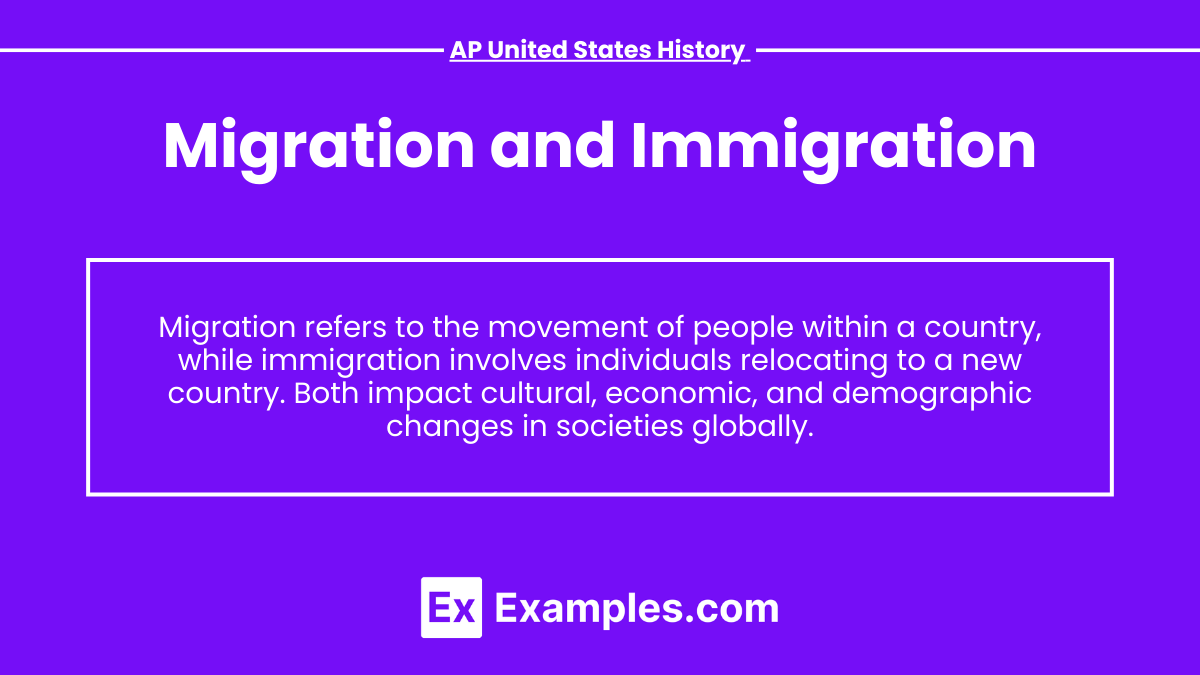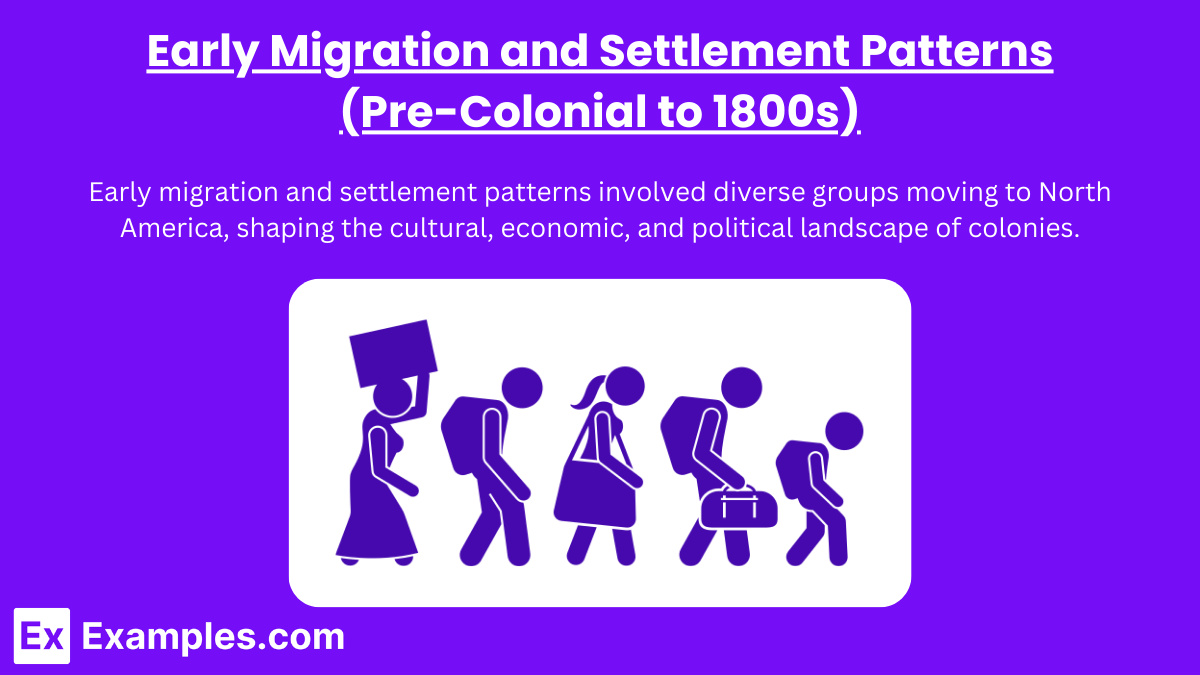Migration and immigration have been defining elements of the AP United States history, shaping its society, economy, and culture. Understanding the patterns, causes, and effects of migration and immigration is essential for the AP United States History (APUSH) exam. Below is a detailed overview of this topic, covering key periods and events.
Free AP United States History Practice Test
Learnig Objectives
By studying Migration and Immigration in U.S. history, you should understand the causes, patterns, and effects of major migration waves, how immigration shaped the economy, culture, and politics, and the evolution of immigration laws. Analyze key events, including the Great Migration, immigration policies, and nativist movements.
I. Early Migration and Settlement Patterns (Pre-Colonial to 1800s)
1. Indigenous Migrations (Pre-1492)
Before European arrival, Indigenous peoples moved and settled across what is now the United States for thousands of years.
Various groups, such as the Cherokee, Iroquois, Navajo, and Sioux, moved for resources, trade, or conflict, shaping distinct cultures and societies.
2. European Colonization and Settlement (1600s-1700s)
Spanish, French, English, and Dutch settlers arrived in waves. Each European power had different colonization strategies:
Spanish focused on the Southwest and Florida, often imposing forced labor (e.g., Encomienda System).
English settled along the East Coast (e.g., Jamestown, Massachusetts Bay) for religious freedom and economic gain.
Indentured servitude became common, particularly in the Chesapeake colonies, allowing Europeans to migrate in exchange for labor contracts.
The Great Migration (1620s-1640s) saw Puritans flee England to Massachusetts due to religious persecution.
3. Transatlantic Slave Trade
By the 1600s, the forced migration of African slaves through the Middle Passage was a crucial part of European colonial economies.
Approximately 12 million Africans were enslaved and transported to the Americas, with around 500,000 brought to the United States.
Slavery’s growth in the Southern colonies was integral to the economy, particularly in tobacco, rice, and cotton production.
II. Immigration in the 19th Century
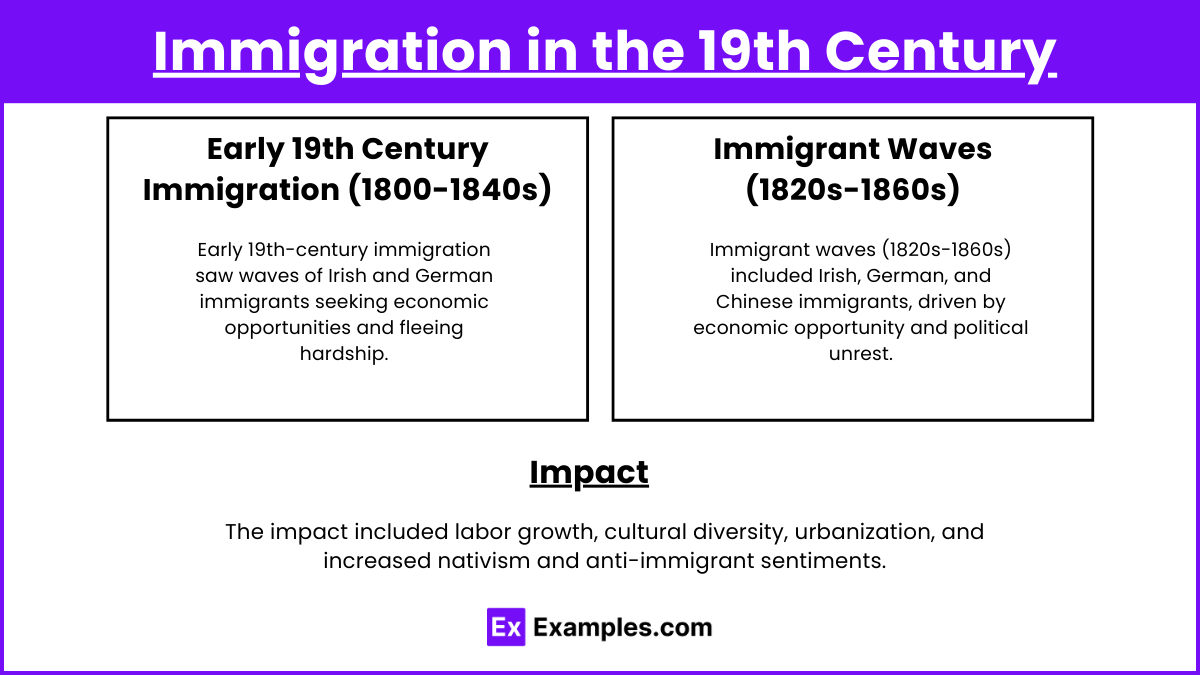
1. Early 19th Century Immigration (1800-1840s)
The United States expanded westward, spurred by events like the Louisiana Purchase (1803) and Manifest Destiny. Migration from the Eastern seaboard into the frontier territories was common.
Internal migration during this period included groups like the Trail of Tears (1838), when the U.S. government forcibly removed Native Americans from their ancestral lands.
2. Immigrant Waves: 1820s-1860s
Irish and German immigrants arrived in large numbers due to political upheaval, famine (e.g., Irish Potato Famine), and economic opportunity.
Irish immigrants faced significant nativism and anti-Catholic sentiment but played key roles in urban development.
Germans often settled in the Midwest, influencing farming and beer brewing industries.
Many of these immigrants contributed to the rise of the Know-Nothing Party, an anti-immigrant and anti-Catholic political group in the 1850s.
III. Late 19th Century and Early 20th Century Immigration (1870-1920)
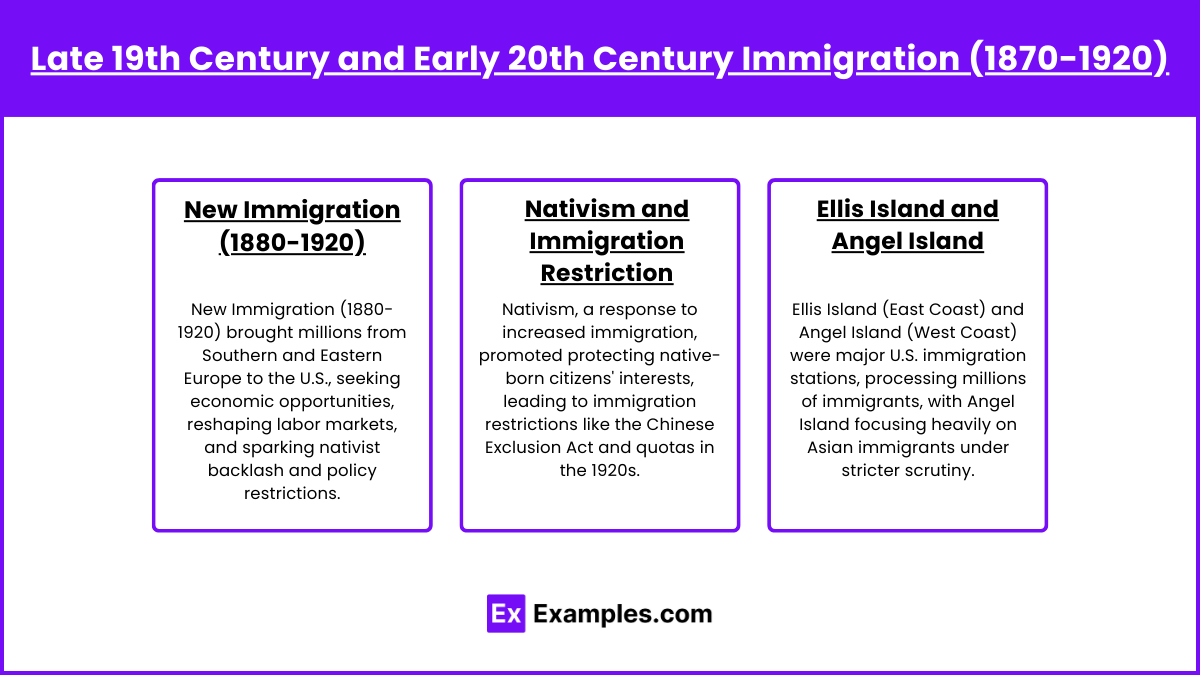
1. New Immigration (1880-1920)
A shift occurred from predominantly Northern and Western European immigrants to Southern and Eastern Europeans (Italians, Russians, Poles, Jews).
These immigrants settled in growing cities like New York, Chicago, and Boston, working in factories, construction, and other low-wage jobs.
The period saw the rise of ethnic enclaves like Little Italy and Chinatown.
2. Nativism and Immigration Restriction
Fear and resentment of new immigrants spurred nativist movements. The rise of the American Protective Association and the Chinese Exclusion Act of 1882 were direct responses to these fears.
The Gentlemen’s Agreement (1907) limited Japanese immigration, while the Immigration Act of 1924 set quotas favoring Western Europeans and severely restricted immigration from Asia and Southern/Eastern Europe.
These restrictions reflected the belief that new immigrants were “unassimilable” and a threat to American society and economy.
3. Ellis Island and Angel Island
Ellis Island in New York Harbor processed millions of immigrants arriving from Europe (opened 1892).
Angel Island in San Francisco Bay processed Asian immigrants, primarily Chinese, from 1910 to 1940. Many faced long detentions and discriminatory policies under the Chinese Exclusion Act.
IV. Migration in the 20th Century
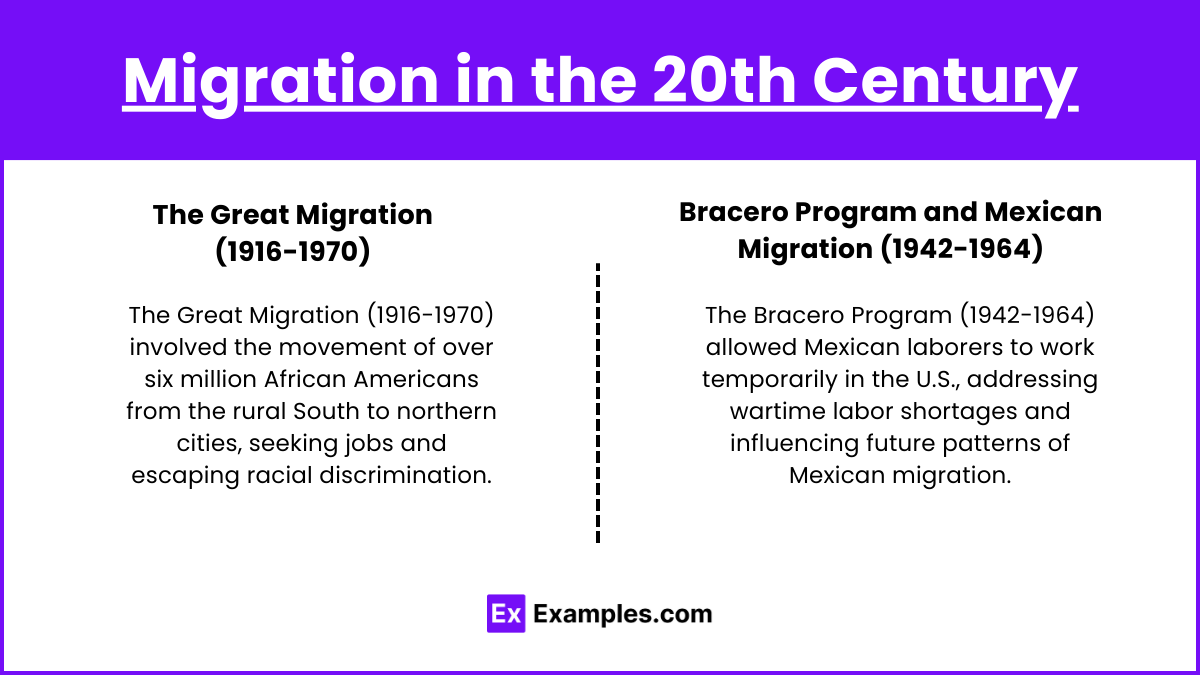
1. The Great Migration (1916-1970)
A large-scale movement of African Americans from the rural South to Northern and Western cities like Chicago, Detroit, and Los Angeles.
African Americans sought to escape the racial violence, Jim Crow laws, and limited economic opportunities of the South, seeking employment in Northern industries during and after World War I and World War II.
This migration reshaped the demographic landscape of the U.S. and laid the groundwork for the Civil Rights Movement.
2. Bracero Program and Mexican Migration (1942-1964)
During World War II, the U.S. faced labor shortages and initiated the Bracero Program, allowing Mexican laborers to work temporarily in agriculture and railroads.
Post-war, many Mexican immigrants settled permanently, becoming part of a broader wave of Latin American migration in the following decades.
V. Modern Immigration Trends (1965-Present)
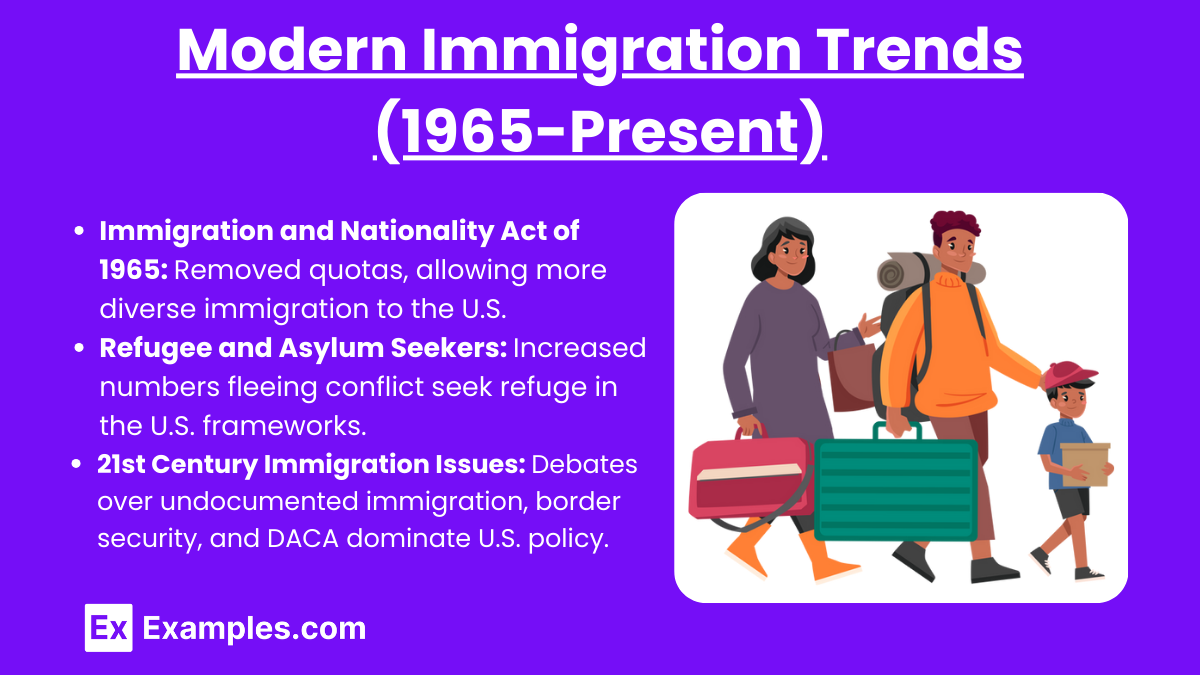
1. Immigration and Nationality Act of 1965
This act abolished the restrictive quota system of the 1920s, which had discriminated against non-European immigrants.
The new system prioritized family reunification and skilled labor, dramatically increasing immigration from Latin America, Asia, and Africa.
This led to a demographic transformation, making the U.S. more ethnically and racially diverse.
2. Refugee and Asylum Seekers
Post-1965 immigration policies allowed for increased numbers of refugees from countries experiencing political upheaval, such as Vietnam, Cuba, and more recently from countries in the Middle East and Africa.
Cuban refugees arrived en masse after the Cuban Revolution (1959), especially during the Mariel Boatlift (1980).
Vietnamese, Laotian, and Cambodian refugees fled after the Vietnam War, settling mainly in California and the Gulf Coast.
3. 21st Century Immigration Issues
Immigration remains a hotly debated issue in modern U.S. politics, particularly in regard to illegal immigration and the status of DREAMers (immigrants brought to the U.S. as children).
Key debates focus on securing the southern border, offering paths to citizenship, and the economic role of immigrants.
Policies like Deferred Action for Childhood Arrivals (DACA) and recent immigration reforms reflect ongoing tensions between inclusivity and restriction.
Examples
The Great Migration (1916-1970): Millions of African Americans moved from the rural South to Northern and Western cities, seeking better economic opportunities and escaping Jim Crow laws.
Irish Immigration (1840s-1850s): A large wave of Irish immigrants came to the U.S. during the Irish Potato Famine, settling in urban centers like New York and Boston.
The Chinese Exclusion Act (1882): This law halted Chinese immigration, reflecting the growing nativist sentiment toward Asian laborers in the late 19th century.
The Bracero Program (1942-1964): A U.S. labor program that brought Mexican workers to fill agricultural and railroad jobs during and after World War II.
Ellis Island Immigration (1892-1954): Processed millions of European immigrants arriving in the U.S., symbolizing the country’s role as a destination for those seeking new opportunities.
MCQs
1. Which of the following contributed to the Great Migration of African Americans in the early 20th century?
A) Industrial jobs in the North
B) The Homestead Act
C) The abolition of slavery
D) The Monroe Doctrine
Answer: A) Industrial jobs in the North
Explanation: The Great Migration saw African Americans move North for industrial jobs, escaping Southern segregation and seeking better economic opportunities during and after World War I.
2. The Chinese Exclusion Act of 1882 was significant because it was the first law to:
A) Grant citizenship to Chinese immigrants
B) Restrict immigration based on nationality
C) Promote immigration from Asia
D) Encourage labor unions
Answer: B) Restrict immigration based on nationality
Explanation: The Chinese Exclusion Act was the first U.S. law that specifically restricted immigration based on nationality, reflecting rising nativist fears about Asian workers.
3. The Immigration and Nationality Act of 1965 primarily changed U.S. immigration by:
A) Reinforcing European quotas
B) Encouraging settlement in rural areas
C) Abolishing the national origins quota system
D) Restricting immigration from Latin America
Answer: C) Abolishing the national origins quota system
Explanation: The 1965 Act ended the national origins quotas, favoring family reunification and skilled workers, thus opening U.S. immigration to diverse global regions like Asia and Latin America.

